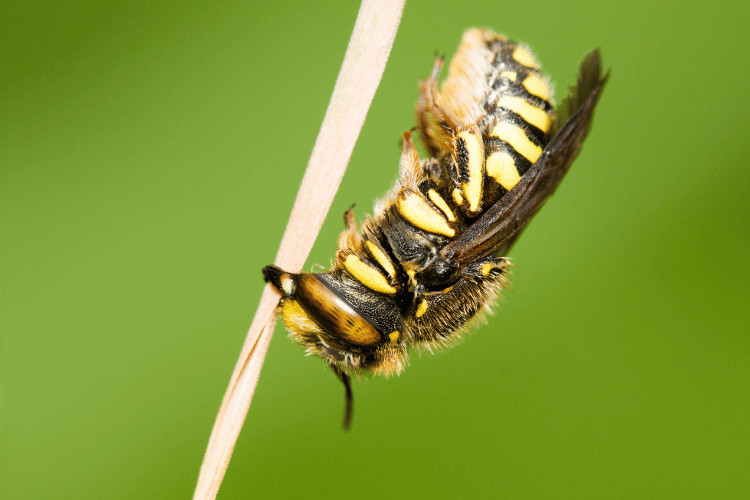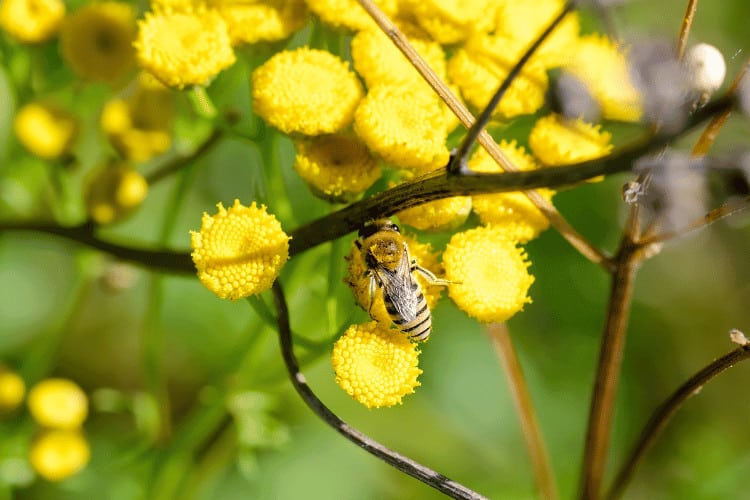Plasterer Bees: Here’s What You Should Know
The world of bees is a lot more diverse than you think. When we picture bees, we imagine a beehive hanging from a tree somewhere with a lot of honey inside and a grizzly bear trying to make its way up there.
While that can be true, it does not apply to all bees. Did you know that there are over 20,000 bee species known to humans? And guess what, not all of them are honey makers!
In today’s article, we’ll shed some light on plasterer bees, understanding their characteristics, behavior, lifecycle, and the reason behind their nickname.
Description and Characteristics of Plasterer Bees

Let’s introduce the plasterer buzzers:
Description: Plasterer bees, scientifically known as Colletes, are a diverse group of ground-nesting bees that play a crucial role in pollination. That’s right, the first difference is that they nest in the ground!
These remarkable creatures can be found across various habitats, showcasing their adaptability to different environments.
Characteristics: Now, let’s talk about some defining characteristics of plasterer bees that set them apart in the buzzing world of pollinators:
- Ground-Nesting Experts: Plasterer bees are known for their nesting behavior in sandy soils. They create underground nests, often in groups, forming intricate tunnel systems that are truly remarkable.
- Hollow Stems and Twigs: These resourceful bees often utilize hollow stems or twigs as nesting sites. Observing this behavior reveals their resourcefulness in utilizing existing structures to build their homes.
- Distinct Markings: Many plasterer bee species sport distinguishable yellow markings, adding a touch of vibrancy to their appearance.
- Hind Leg Characteristics: Pay close attention to their hind legs, as they often carry distinctive features such as specialized hairs or structures tailored to their unique nesting behaviors.
- Variety of Species: Plasterer bees belong to the Colletes genus, which comprises various species, each with its own intriguing habits and preferences.
- Native Pollinator Champions: These bees are essential native pollinators, contributing significantly to ecosystem health and supporting plant reproduction (More on that soon!)
The Collet family has so many members like Colletes Titusensis, Colletes Succinctus, Colletes Hederae, and Heather Colletes.
What Is the Purpose of Plasterer Bees?
These bees contribute significantly to ecosystem health by aiding in pollination. As efficient pollinators, they facilitate the reproduction of various flowering plants, ensuring biodiversity and supporting the food chain. Beyond pollination, plasterer bees also play a role in soil health by creating burrows that enhance aeration and drainage.
This, in turn, benefits other organisms in the soil ecosystem. Their presence exemplifies the interconnectedness of nature and highlights the importance of preserving these native pollinators for a balanced environment.
Fun fact: Did you know that plasterer bees don’t make honey? While they serve the environment in many ways, producing honey isn’t one of them.
Plasterer Bees: Habitat and Foraging Preferences
Plasterer bees are often found in a range of habitats, from urban gardens to natural landscapes. They exhibit preferences for nesting in sandy soils or loose, well-drained substrates.
These adaptable bees are known to select sites like garden beds, slopes, and even sand dunes to construct their underground nests.
When it comes to foraging, plasterer bees display a specialized affinity for certain flowering plants, including those with hollow stems and tubular flowers. By targeting these specific plants, they efficiently collect pollen and nectar, contributing to the pollination of these species.
Where Can You Find Plasterer Bees
Plasterer bees can be found throughout North America. Their wide distribution encompasses diverse habitats, making them a vital component of local ecosystems.

These diligent bees can be spotted in various regions, from the eastern United States to western Canada, demonstrating their adaptability to different climates and environments.
These bees have established their presence in both urban and natural landscapes. In urban settings, you might find them buzzing around gardens, city parks, and green spaces. Their resilience to urbanization highlights their ability to thrive even in human-modified environments.
In natural habitats, plasterer bees are often found in grasslands, meadows, prairies, woodlands, and open fields. Their preference for areas with abundant floral resources showcases their important role in pollinating a variety of native plants.
Plasterer Bees Life Cycle, Mating, and Nesting
These bees are solitary creatures, each female working independently to build and maintain her underground nest. Their life cycle spans several stages, from egg to adulthood, showcasing their resilience in the face of environmental challenges.
Egg and Larval Stages
The life cycle begins as a female plasterer bee digs a small burrow in the ground. Inside each burrow, she constructs individual nest cells, each containing a mixture of pollen and nectar.
Once the nest cell is prepared, she lays a single egg on the pollen mixture. This egg hatches into a larva, which consumes the stored pollen and nectar as its primary food source.
Pupal Stage
After consuming enough food, the larva enters the pupal stage. During this phase, it undergoes metamorphosis, transforming into an adult bee within the confines of the protective nest cell.
Adult Stage and Mating
Once fully developed, the adult bee emerges from the nest cell. Male and female bees of the same species engage in intricate mating rituals.
Male plasterer bees often establish territories where they perch and await receptive females. Upon mating, females gather the necessary resources to construct their own nests.
Nesting Behavior
Plasterer bees are aptly named for their unique nesting technique. Females construct nest cells using a mixture of soil and saliva. This is how they earned their nickname.
They form a plaster-like substance that lines the walls of each cell, providing insulation and protection for the developing larvae. The entrance to each nest cell is capped with a cellophane-like substance, shielding the contents from potential predators.
This life cycle demonstrates the fascinating adaptations of plasterer bees, showcasing their role as ground-nesting pollinators and their commitment to nurturing the next generation.
Importance of Plasterer Bees in Ecosystems and Agriculture
Plasterer bees play a crucial role in maintaining the delicate balance of ecosystems and supporting agricultural productivity. Their efficient pollination activities contribute to the reproductive success of numerous plant species, ensuring biodiversity and ecosystem health.
In agriculture, plasterer bees enhance crop yields by facilitating the pollination of flowering plants, including fruits, vegetables, and nuts.
Their diligent foraging behavior and ability to transfer pollen from flower to flower contribute to the production of high-quality, nutrient-rich crops that benefit both human and animal populations.
Furthermore, their preference for ground nesting and sandy soils aids in soil aeration and health, promoting plant growth and nutrient cycling
Common Questions About Plasterer Bees
What Do Plasterer Bees Eat?
Plasterer bees eat pollen and nectar, which they collect from a variety of flowers. They are especially attracted to flowers in the aster family, such as daisies, sunflowers, and asters.
The pollen and nectar provide the protein and carbohydrates that the bees need to survive.
Are Plasterer Bees Dangerous?
Plasterer bees, like most native solitary bees, are not dangerous to humans. They are docile and rarely show aggressive behavior.
Male plasterer bees don’t possess stingers, and females, while having stingers, are extremely unlikely to sting unless directly threatened or handled. Their focus is on foraging for pollen and nectar and tending to their nests.
What Size Are Plasterer Bees?
Plasterer bees are about the size of honey bees, ranging in length from 7 to 16 mm (0.28 to 0.63 in). They are black with pale bands of hair on their abdomen. Their wings are transparent and lie flat on their backs when they are resting.

It is important to note that the size of plasterer bees can vary depending on the species. For example, the largest species of plasterer bee, Colletes inaequalis, can grow up to 18 mm (0.71 in) long.
How to Identify Plasterer Bees?
Here are some key features to look for when identifying plasterer bees:
- Size: Plasterer bees are about the size of honey bees, ranging in length from 7 to 16 mm (0.28 to 0.63 in).
- Color: Plasterer bees are black with pale bands of hair on their abdomen. The bands can be white, yellow, or orange.
- Wings: The wings of plasterer bees are transparent and lie flat on their backs when they are resting.
- Head: The head of a plasterer bee is heart-shaped and has large eyes.
- Abdomen: The abdomen of a plasterer bee is slender and tapers towards the end.
How to Attract Plasterer Bees
If you have a garden, and you’d like to see some plasterer bees in it, here’s what you can do:
- Plant flowers that they like. Plasterer bees are attracted to flowers in the aster family, such as daisies, sunflowers, and asters. They also like flowers that have a lot of pollen, such as clover and dandelions.
- Provide bare soil. Plasterer bees nest in the ground, so it is important to provide them with bare soil where they can dig their nests. You can do this by creating a patch of bare soil in your garden or by adding sand to your flower beds.
- Avoid using pesticides. Pesticides can be harmful to bees, so it is important to avoid using them in your garden. If you must use pesticides, be sure to use them sparingly and only when necessary.
- Create a water source. Bees need water to survive, so it is important to provide them with a water source in your garden. You can do this by placing a birdbath or a shallow dish of water in your garden.
- Keep your garden free of weeds. Weeds can compete with flowers for nectar and pollen, which can make it difficult for plasterer bees to find food.
- Monitor your garden for pests. Pests can harm bees, so it is important to monitor your garden for pests and take steps to control them.
The Verdict
Plasterer bees stand out from the “bee image” in most people’s heads. That’s because they don’t produce honey, and they nest in ground tunnels where they keep their young and store food.
Nevertheless, you can still attract them to your garden by utilizing the tips mentioned above. Keep an eye out for their appearance and size to identify them, and once you do, avoid provoking them to keep them coming.
